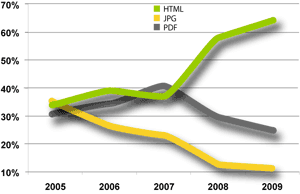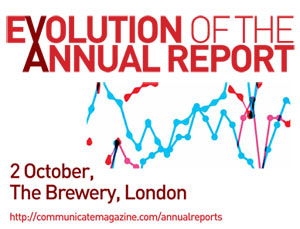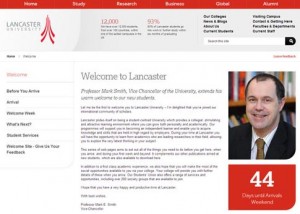
Nexxar posted this graph via Twitter today, showing the change in the presentation of annual reports by FTSE 100 companies over the last few years.
It shows very clearly that an increasing number of companies over the last couple of years have decided to go for an online HTML annual report, rather than purely PDF or JPG implementations.
We think this is good news. Although we like to see PDFs available for download on the corporate website (ideally indexed, so that visitors can select just the part of the report that interests them, if they choose, rather than the whole unwieldy document), this is in addition to an online annual report. Having the report online, rather than just in PDF, saves the visitor time and makes it easier for them to find the information that they need.
Even now, many visitors will still be using dial-up services rather than broadband – either by choice or because that is all they have access to – and a big download can take a long, long time. Even in those areas of the country where broadband is available, it isn’t usually the superfast kind that a few urban areas of the country have access to.
So an online annual report makes it much quicker for the visitor to find information. It also makes it easier, because better cross-linking and navigation can be put in place in an HTML implementation, along with clever tools that enhance the information provision with elements of interactivity.
And it seems that despite the recession, companies agree that the HTML report is preferable; as shown by the Nexxar graph. This is rapidly becoming the de facto standard, not an extra.
So, when everyone has an online annual report, how will you make yours stand out?
Lucy is Editor at Corporate Eye



Hi Lucy,
great post, I will come up with some more information on my blog in the next days. Just wanted to add the reason for the big change in portions in 2008 was a regulatory change regarding the default delivery of annual reports. Until 2008 it was necessary for any listed company in the UK to send a printed copy of their annual report to every single shareholder.
Lots of paper wasted, not very eco-sensible! In 2008 this changed to a notice and access model. Now only those shareholders opting in to receive a printed copy will get on, all others will be send a link or PDF via Email.
Best,
Thomas
Hi Thomas
That’s a good point; thank you for pointing it out. And it’s an important change of mindset: why waste money and trees on sending out information on paper unnecessarily? Moving to an electronic version for those who are happy with that makes a lot of sense. So providing the electronic version in a suitable form (easy to use, attractive, well-branded) became more important.
And the competition becomes less ‘who has the best (paper) designer/printer’, and more ‘who can provide their information in the most flexible, intuitive and helpful way’.
If the shift was simply because of the regulatory change, I think there wouldn’t have been the same rapid takeup of the HTML versions; after all, the JPG/PDF versions do the same job as the paper-based versions – often mimicking the paper versions exactly.
I think that the steep angle of that curve is because people realised how much better the HTML versions are (or can be) at providing the information in a way that is more useful to the visitor. And that’s got to be good – as long as people can still get hold of a paper copy if that’s what they prefer.
What about annual reports in different formats? Braille? Audio? Though some of the HTML versions I’ve seen recently have been excellent, I wonder how easy it is to get hold of reports in these different formats now?
Hi Lucy-
Curious if you’ve seen any online annual reports that were designed or implemented exceptionally well? You mention that you’ve seen some excellent ones.
Hi Chris – now there’s a question! I don’t usually spend a lot of time reviewing annual reports, so these aren’t necessarily the best out there but off the top of my head…
Barclays 2008 is very striking indeed; so is the StatOilHydro 2008 report (once loaded – it is quite slow).
I like the tools offered by many of the German companies, such as ‘compare to last year’; I like the chart-creation options in, for example, Nexen – create a chart of the financial figures you’re interested in, then download the data for that chart in Excel.
I like the way that PotashCorp explain their business in a dedicated section (Six Keys) with explanatory graphs that popup, and links to more information.
And RWE have an interesting sidebar ‘catchwords’ function, which lets you search for relevant information on hot topics (such as emissions, or remuneration, for example) highlighting elements in the left hand nav that you might be interested in.
Have a look at those, and do let me know if you agree!
Anybody else got particular favourites? Please share…
Hi Guys,
Although more annual reports are provided in accessible PDF format for visually impaired shareholders, the demand for hard copy transcriptions is still high.
We produce several annual reports in Braille, audio and large print for a variety of FTSE 100 companies and work to very tight deadlines. We also produce MP3 versions which can be downloaded to MP3 players.
Anyone interested in our services should not hesitate to contact us.
Morrison Ellis
General Manager
TransMedia Link
Hi Morrison
Thanks for your comment – I’m glad to learn that annual reports are still available in Braille, large font etc. I’m sure I used to see information about obtaining ARs in Braille / large font /audio on at least one corporate website a while ago (might have been Barclays) but haven’t noticed it recently… I’ll look out for it again.
Do you think that companies are producing these alternative formats but not publicising it on the corporate website? Can you tell us (without breaching confidentiality) whether these alternative media ARs are produced on demand, or whether there’s a small run each year in all formats so that there are some in stock in case of demand?
Hi Lucy,
Some master the formats in readiness for requests, others just wait until they get a request and produce them then.
There are still several companies however who are pro-active and mail out alternative media at the same time the standard print materials go out. This is the best option as all recipients can access the information at the same time and make informed decisions.
As regards publicising on corporate websites, I agree it isn’t always clear if these formats are available.
Best wishes,
Morrison
That was a quick response – thank you!
I suppose that some companies know that they have N shareholders who need X format, but there must always be some requests from people who haven’t yet been in touch with the company, so the exact numbers must be unpredictable… and as the number of alternative formats increases, this must become an ever bigger problem for the company, though a great opportunity for you.
Very interesting; thank you for sharing.
like this? :-)
annualreport.bekaert.com
Hi Stephen – that looks very smart. I particularly like the way it pages for easy reading, and the Share This feature in the sidebar of every page. Also the promise to get back to me within 2 days if I send a question or comment in via the contact page.
And I like the idea of the one-click Add to My PDF, though my browser doesn’t like it much (problem with my setup, I should think).. Should this add the single page I’m viewing to My PDF, or does it add the entire section?